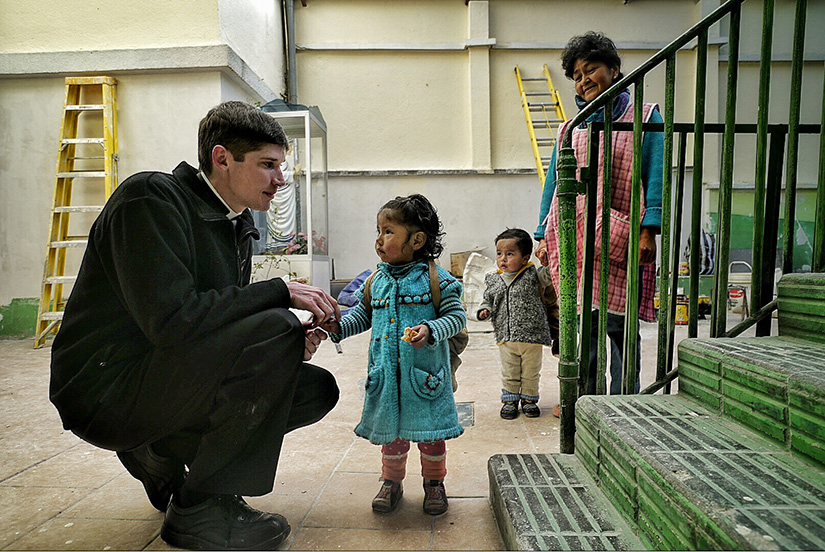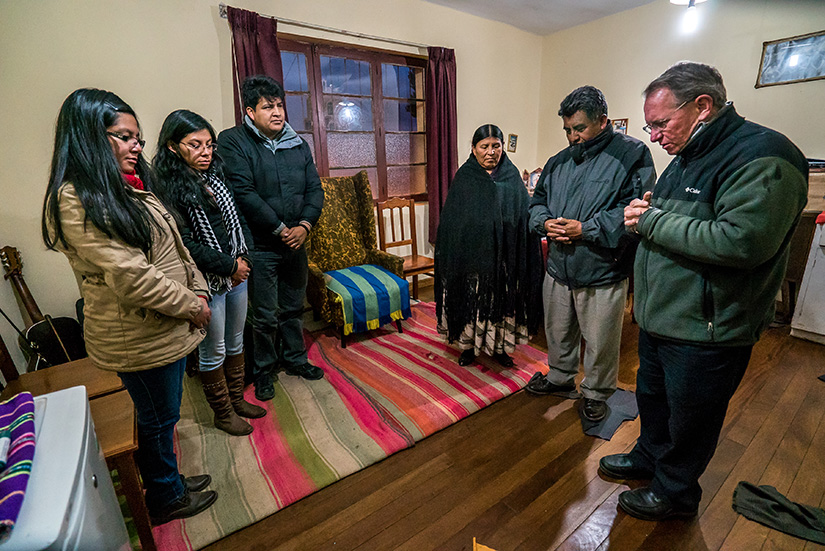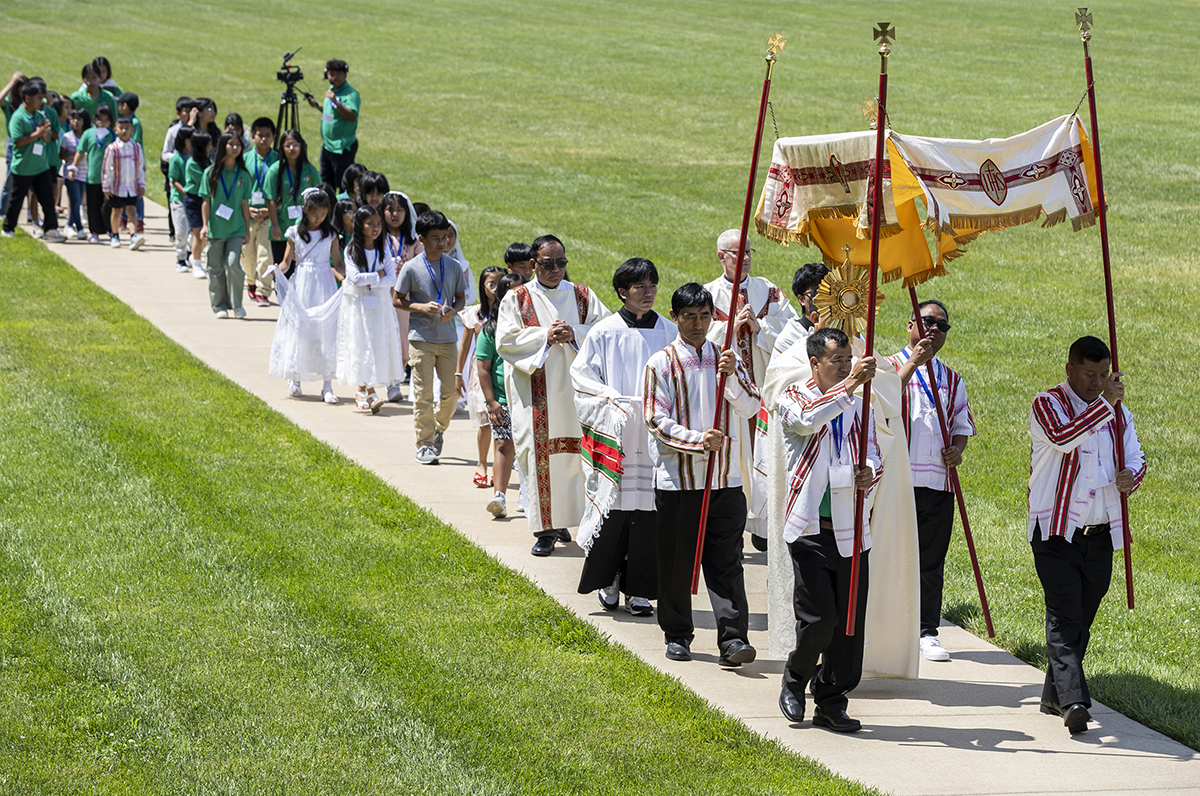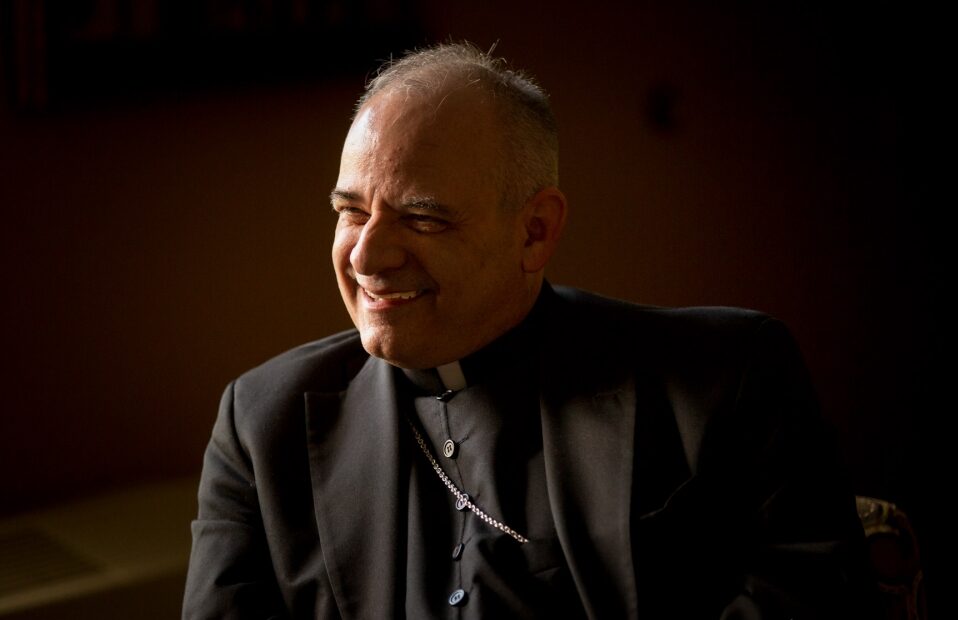Parish in Bolivia to be handed over to La Paz Archdiocese

St. Louis priests staffed parishes through Latin America Apostolate for 64 years
Maria Reina Parish in Bolivia — the last parish in the South American country staffed by priests of the Archdiocese of St. Louis — is being handed over to the Archdiocese of La Paz. The change ends 64 years of service in South America by priests in the St. Louis Archdiocese’s Latin America Apostolate.
The Mission Office will provide financial support to Maria Reina (Mary Queen) Parish throughout 2021, helping to offset the economic effects of the COVID-19 pandemic and for the transition of new staff. Last month, Archbishop Percy L. Galván Flores of La Paz appointed Father Juan Carlos Choque and Father Jaime Florencio Álvarez del Carpio to serve the parish.
Father Patrick Hayden was serving as pastor of Maria Reina and was the only priest left at the parish. Father Timothy Noelker returned to St. Louis in 2017 and is now pastor of St. Cecilia Parish. Father James Michler returned late last year and is awaiting a new assignment. Fathers Hayden and Michler each served more than 25 years at Maria Reina. About 45 priests served in the apostolate in Bolivia. Two archdiocesan priests who served in the apostolate became auxiliary bishops of La Paz and then bishops of the Vicariate of the Pando in Bolivia — Bishop Andrew Schierhoff and Bishop Morgan Casey.
Mission work continues

The Archdiocese of St. Louis will maintain a relationship with the Archdiocese of La Paz beyond 2021 by including it in the Mission Office’s Missionary Plan of Cooperation. In this program, parishes hear appeals for specific missions around the world, offering their prayers and sacrifices for that particular mission. “In this way, the Archdiocese of La Paz will remain in the hearts of our parishioners in St. Louis,” said Kim Becvar, interim director of the Mission Office of the Archdiocese of St. Louis, in a memo on the matter.
While the Archdiocese of St. Louis will soon no longer be physically present in La Paz, “we will continue to be united in our common mission to bring the Gospel to all,” Becvar stated.
The Mission Office continues serving the global Church by supporting the more than 1,100 mission territories through the Pontifical Mission Societies. A popular program is the Daily Worldmissionnaires, men and women who pledge to support the Society for the Propagation of the Faith through daily prayer, sacrifice and financial support. The office also continues Pan y Amor, a mission aid program primarily for needy children in Bolivia but also in Colombia, Kenya and Uganda.
Challenge accepted
St. Louis was the first archdiocese to accept the challenge of Pope Pius XII in his 1955 encyclical, “Fidei Donum,” that diocesan priests be sent into foreign missionary fields. Until then, the work was limited to missionary orders such as the Jesuits and Maryknolls.
Archbishop Joseph Ritter received a request from the Archbishop of La Paz, Bolivia, for priests due to a shortage of native clergy there. He mentioned it to a group of priests who encouraged him to ask for volunteers. The result was the departure of three young priests — Fathers Andrew A. Kennedy, Andrew B. Schierhoff and David A. Ratermann — in May of 1956 for the missionary task.
The St. Louis priests founded Cristo Rey (Christ the King) Parish for 30,000 parishioners in an area carved from a parish of 70,000 served by Maryknoll priests from the United States. In the next 10 years, four more parishes were added to the apostolate — Mary Queen in La Paz, St. Augustine in Viacha, St. James in Calamarca and Holy Family in Arica, Chile. They not only were staffed by archdiocesan priests but had spiritual and financial support from the people of the Archdiocese of St. Louis.
In addition, the Sisters of the Most Precious Blood of O’Fallon founded a mission to work with the St. Louis priests and played an important role. They operated a mobile clinic, helped with catechesis, led a sewing group, taught school, operated a health clinic and shelters for homeless children and for women. The Sisters of Loretto also established a mission in Bolivia. In the 1960s, a program called Papal Volunteers in Latin America brought lay missioners.
In a Review article in 1976, Msgr. Ratermann said that they served a small group of people from the middle class and numerous rural peasants, many living in the cities; they had little education and searched for odd jobs, earning poverty-level wages. Communication struggles existed since many of them spoke native languages.
Upon the apostolate’s 20th anniversary, Cardinal John J. Carberry summed up the reason for the success of the apostolate was because the missionaries have become “the instruments of a labor to bring God’s redeeming love to more people.”
Father Daniel Stretch, another longtime missionary, made a significant impact with people with disabilities and helping at a home for homeless men who are alcoholics. He said in 1980 that the apostolate’s long-term goal was to help Bolivians staff their own parishes.
>> Reflections from former missionaries
Father Timothy Noelker, pastor of St. Cecilia Parish in St. Louis, views his five years serving in the Latin America Apostolate as a privilege.
“I was blessed to know many people of incredible faith, many times incredible hardships as well but their faith shined brightly,” Father Noelker said. He has “wonderful memories of sharing life with people in their joys, their sorrows, their good times and bad.”
He was received with open arms and open hearts by the people of La Paz and “served with some of the finest priests I’ve known,” providing an inspiring and humbling example.
He’s saddened that St. Louis priests will no longer be present in La Paz but is consoled by the knowledge that the fruits of the labors of so many missionaries and generous laypeople throughout the Archdiocese of St. Louis continue. It’s normal that missionaries hand on a parish to local clergy after some time, he said.
Bishop Morgan Casey, who served in Bolivia more than 50 years, pointed out that the Archdiocese of St. Louis was the first to have diocesan priests from the United States to go to Bolivia and also is the last to leave. “It’s outstanding the number of years the St. Louis Archdiocese has supported so strongly the apostolate,” he said.
He commended the generosity of the people of St. Louis who provided their funds and prayers.
Bishop Casey reported that one of the priests from the Archdiocese of La Paz who will serve at the last parish staffed by St. Louis priests, Maria Reina, had spent time as a seminarian doing pastoral work at the parish and will carry on the many good things he learned from his brother priests from St. Louis.
Father James Michler, who is celebrating Mass in Spanish at several parishes in the St. Louis Archdiocese while awaiting a new assignment, said he was blessed by living with a prayerful community of priests in La Paz. He also was supported by couples he met through Marriage Encounter and saw the need for priests to support couples. “Those were good experiences. I learned a lot being in Bolivia,” he said.
Father Michler’s years in Bolivia gave him an appreciation of growing up in St. Louis with a Catholic family whose parents were devoted to their children. In Bolivia it was difficult for families to be united, and sometimes children didn’t have a good father figure, he said. It also was difficult for him to see people in poverty who died because of a lack of access to good medical care.
Maria Reina Parish in Bolivia — the last parish in the South American country staffed by priests of the Archdiocese of St. Louis — is being handed over to the … Parish in Bolivia to be handed over to La Paz Archdiocese
Subscribe to Read All St. Louis Review Stories
All readers receive 5 stories to read free per month. After that, readers will need to be logged in.
If you are currently receive the St. Louis Review at your home or office, please send your name and address (and subscriber id if you know it) to subscriptions@stlouisreview.com to get your login information.
If you are not currently a subscriber to the St. Louis Review, please contact subscriptions@stlouisreview.com for information on how to subscribe.






